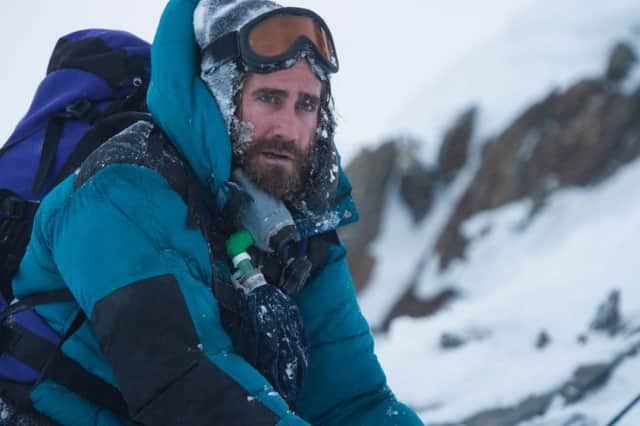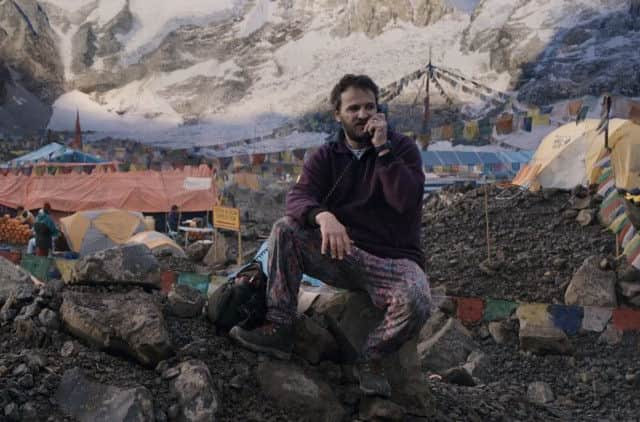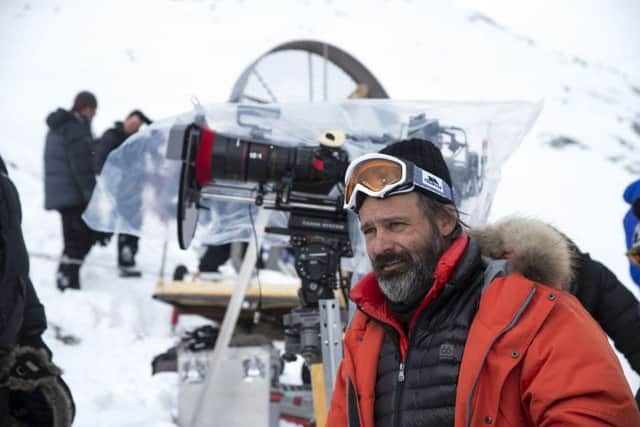Interview: Baltasar Kormákur, Everest director


‘Because it’s there.” Those three words, perhaps the most famous in mountaineering, were spoken by George Mallory. They have become a cliche, a way to dismiss the question as to why anyone would risk their life to climb a mountain, as much as an answer to it. Mallory uttered the words in March 1923, after two failed attempts to reach the summit of Mount Everest. He returned in 1924 for his third and final attempt. The last sighting of him and his climbing partner Sandy Irvine was from 2000ft below, two “black spots” crawling up the summit ridge. But Mallory also posed a question of his own before that fateful ascent: “Why do we travel to remote locations?” His answer: “We do it to be alone amongst friends and to find ourselves in a land without man.”
No-one could use that description of Everest these days. More than 4,000 people have now reached that summit, five miles above sea level at 29,029ft, surrounded in air so thin if you were dropped at the top without oxygen or time to acclimatise you’d be lucky to survive for two minutes before losing consciousness. Since 1986, when the Nepalese government changed the law to allow anyone who could afford it to go there, the world’s highest mountain has become in some ways a tourist attraction, albeit an exclusive one.
Advertisement
Hide AdIcelandic director Baltasar Kormákur’s movie Everest is a visually stunning but also emotionally engaging film set in 1996 when the business of climbing Everest was in its infancy. It was 43 years since Edmund Hillary and Tenzing Norgay first stood together on the summit, but on that day in 1996, there were 34 climbers from multiple expeditions all aiming to make it to the top of the mountain. They queued to get across gorges, picking their way towards a peak that sits at the height at which a Boeing 747 cruises, in roped-up human chains, like ants on a hillside.


Two expeditions, one led by New Zealander Rob Hall and another by American Scott Fischer, aimed to reach the summit on 10 May. Both Hall and Fischer were respected climbers and pioneering expedition guides. Their teams were made up of climbers with a range of experience, some of whom had tried to reach the summit before (American Doug Hansen, a postman who’d been turned back by Hall just a whisker from the summit the previous year), as well as journalist and climber Jon Krakauer, who went on to write the book Into Thin Air about his experience and Texan pathologist Beck Weathers who suffered horrendous injuries and also wrote a book, Left for Dead: My Journey Home from Everest, about the events of that fateful day.
Both Hall and Fischer, and their teams, understood the perils of Everest only too well. What no-one could have accounted for was a brutal storm which swept up through the valley just after most of the teams had reached the summit, engulfing the mountain, battering the climbers with brutal winds and snow and plunging the temperature to -40 degrees. Eight people lost their lives, including Hall, Fischer and Hansen. In the aftermath, as people tried to understand what had gone wrong, the debate about who should climb such mountains was ignited.
“It was the beginning of the commercialisation of Everest,” Kormákur says. “At that time we were a bit more innocent about it. Now it’s really relevant for us. I come from a country [Iceland] that’s really dealing with this – every day it’s in the media, people flying up to erupting volcanoes taking selfies, almost falling into waterfalls because they’re not adequately secured. The situation is crazy. We’re not ready for it and nature’s not ready for it. What interests me is why this started, why people create these things?”
As of February 2014, there had been 6,871 ascents of Everest by 4,042 different climbers. In total, 265 people have died on the mountain. The storm that claimed the lives of Hall, Fischer, Hansen, Andy Harris and Yasuo Namba, as well as three climbers from a group of Indo-Tibetan Border Police was, at the time, the deadliest day of Mount Everest’s history. It was a grim record only replaced when on 18 April 2014, 16 high-altitude workers, including 13 Sherpas, were killed in the Khumbu Icefall below camp one, following a serac collapse on the mountain’s west shoulder.


What was of vital importance for Kormákur in the making of his film was to create a balanced and humane portrait of those involved – he wasn’t looking to find villains, he felt no need to ramp up the drama. His aim was to tell a story that was fair to all of those involved. He was, he says, “very lucky” that after beginning his research by reading everything he could get his hands on about the event, including the books written by Krakauer and Weathers, to go to New Zealand and meet Jan Arnold, Hall’s then partner who was seven months pregnant with their first child when Hall perished, Helen Wilton, the base camp manager for the expedition and climber Guy Cotter who was also on the mountain that day. “They allowed me to listen to tapes that were recorded that day,” Kormákur says. “Nobody had listened to them before. Some people might’ve heard radio activity on the mountain but these are the whole trip recorded, everything through the radio talk.
Advertisement
Hide Ad“They hadn’t listened to these tapes for 18 years because obviously they wanted to move away from the terrible tragedy. Listening to them and opening up the wound was incredibly emotional. They let me into their world.”
It was also enormously informative. The smallest details were captured there and having that uniquely authentic source material to work from made Kormákur determined not to either justify or criticise the decisions made before or after the ascent and descent. “Pointing the finger at someone, creating a hero to save the day – all of these things that even people who are making documentaries these days tend to do to make it commercial and accessible,” he says. “They villainise people for dramatic reasons. I wanted to make it true, real and just let people open up to it. They feel like real people and so when the storm hits you feel for them, not because we forced you to but because we allowed you to.”
Advertisement
Hide AdOf course this had an impact on what Kormákur wanted from his actors, a stellar cast including Jake Gyllenhaal, Emily Watson, Keira Knightley, Jason Clarke and Josh Brolin. He wanted a kind of “non-acting”, naturalistic performances that stripped back the story of what happened to its essential elements. “I wanted to do that both in terms of settings and the characters,” he says. “That kind of Oscar-baiting performance, all the gimmicks that are used in acting that are constantly rewarded, I’m not that fond of it. Real acting is about giving people an insight into a person, letting the audience in.”
And he went to quite some lengths to achieve it. The film was shot in the foothills of Everest, in the Italian Alps and also in Pinewood Studios, where a huge freezer was constructed so that it was real snow with which the actors were pelted. In the mountains, there were no assistants to carry packs or offer the usual pampering to which Hollywood stars are accustomed. Everyone slept in unheated tents and cast and crew all ate the same food.
“When the cast and crew arrived the fear was palpable,” says Kormákur. “Then you walk with your own stuff, no assistants, everyone whether you are a grip or a Hollywood star eating the same food, Sherpa food, there’s nothing else up there. We are suddenly becoming a team of people working together as climbers. We are at the mercy of nature, we cannot control what we can shoot and what we can’t shoot, we have to accept what we’re given. It makes everyone really raw and that’s where you start drawing the performances from. You can’t stand in nature, in the real place and start making a gimmicky, theatrical performance. It just goes wrong.”
People were hit with altitude sickness, for some it was all a bit too much. “I had people saying I want to get out of here, I don’t want to do this any more, I’ve made a mistake.” Who? “Actors and crew. They were getting scared. They couldn’t control the situation any more and that’s really when it starts getting interesting. It’s at that point that we can really start working.”
Movies are always team efforts, hugely so, but with logistical issues such as shooting in ever changing weather in both Nepal and in the Italian Alps, that was never more true than with this project. “We had 30 Sherpas with us the whole time, both in Nepal and in Italy. Everyone in the crew – there’s no way you’re going to be the asshole on that mountain, either you’re with me doing this or you’re going home. And some people did go home. But I loved it because we were at the mercy of the mountain. What were we allowed to shoot? It was like being a climber on the mountain – what are you allowed to do today?”
Kormákur didn’t set out to answer the question as to why people climb mountains. He knows that every climber you ask will give you a different answer. “Why do people race cars? Why do they dive into deep oceans?” he says. “In some ways it’s the essence of life – you squeeze as much experience as you can, you live really at the edge for a while.”
Advertisement
Hide AdThat doesn’t mean, though, that he hasn’t developed a different appreciation of why people are driven to undertake feats that push them to their limits. “What I can tell you is when I was going there, when I was on the mountain, I could feel the seduction. It wasn’t like I wanted to put it on my bucket list, my bucket list is all about film, but there’s something existential about it. I ride in the Highlands of Iceland every year. I go for two weeks into the wild with my horses. It’s the hardest holiday you can take, you are riding for 14 hours day and when I get home my body is so tired but my mind is fresh. It’s a cathartic experience and you can deal with all the problems and bullshit in your regular life and work for the whole winter.”
So it’s a case of perspective?
“I always think of the astronaut who said that when he could put Earth behind his thumb and it disappeared it changed his perspective for the rest of his life. Nothing was ever the same.”
• Everest is in cinemas on 18 September.